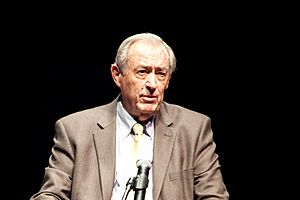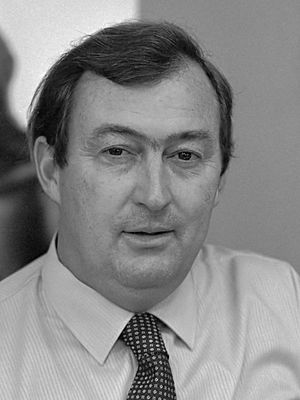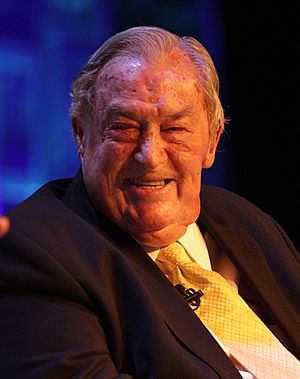Richard Leakey facts for kids
Quick facts for kids
Richard Leakey
|
|
|---|---|

Richard Leakey in 2010
|
|
| Born | 19 December 1944 |
| Died | 2 January 2022 (aged 77) Nairobi, Kenya
|
| Nationality | Kenyan |
| Scientific career | |
| Fields | Paleoanthropology |
Richard Leakey (born December 19, 1944 – died January 2, 2022) was an important Kenyan politician, a scientist who studied ancient humans (called paleoanthropologist), and a conservationist. He was the second of three sons born to famous anthropologists Louis Leakey and Mary Leakey. In 2007, he became a member of the Royal Society, a group of top scientists.
Contents
Richard Leakey's Early Life
Richard Leakey left high school early. He found his passion for studying ancient life forms (called paleontology) when he led a trip to a fossil site he saw from a plane. At first, people didn't take him seriously because he didn't have a college degree.
He went to England to study, but after six months, he came back home. He wanted to continue his safari trips. He never finished his degree.
In 1965, he married Margaret Cropper. Their daughter Anna was born in 1969. Richard and Margaret then divorced that same year. He later married his fellow scientist, Meave Epps, in 1970. They had two daughters, Louise (born 1972) and Samira (born 1974).
Health Challenges and Recovery
In 1969, doctors told Leakey he had a serious kidney disease. Ten years later, he became very ill. Luckily, his brother Philip gave him a transplanted kidney, and Richard got better.
In 1993, a small plane Richard Leakey was flying crashed. His lower legs were badly hurt. Both legs later had to be removed. Some people thought it was done on purpose, but this was never proven. Within a few months, Richard Leakey was walking again using artificial legs.
In his book about his life, Richard Leakey shared that he did not believe in God.
Starting His Own Businesses
Richard decided to earn his own money. He borrowed some money from his parents to buy a Land Rover. He started a business with Kamoya Kimeu, catching animals and selling their skeletons.
Richard was already good at riding horses, living outdoors, fixing Land Rovers, and leading trips. He also learned to identify bones. All these skills pointed him towards a path his father was on, but he didn't want to follow it just yet.
His bone business changed into a safari tour business in 1961. In 1962, he got his private airplane pilot licence. He started taking tours to Olduvai, a famous fossil site. From a quick flight, he noticed that the shores of Lake Natron might have many fossils.
He searched for fossils there in his Land Rover but found none. Then, his parents asked Glynn Isaac to join him. Louis Leakey was very impressed with what they found. He gave them money from National Geographic for a month-long trip. They explored near Peninj by the lake, where Richard managed the trip details.
Richard got bored and went back to Nairobi for a short time. While he was away, Kamoya Kimeu found a fossil skull of an ancient human relative called Australopithecus boisei. A second trip made Richard feel left out of the most important part: the scientific study of the finds.
Richard Leakey's Fossil Expeditions
Discoveries at Koobi Fora
During a trip to the Omo area in 1967, Richard visited Nairobi. On his flight back, the pilot flew over Lake Rudolph (now called Lake Turkana) to avoid a storm. Richard expected to see volcanic rock below, but he saw layers of sediment instead. When he visited the area by helicopter, he saw ancient tools and fossils everywhere. He immediately started planning a new project.
In 1969, they found a skull of Paranthropus boisei, which was very exciting. Later, a Homo habilis skull (found in 1972) and a Homo erectus skull (found in 1975) were among the most important finds from Leakey's early trips. In 1978, a complete skull of Homo erectus was discovered.
Richard Leakey and Donald Johanson were considered the most famous paleoanthropologists at the time. They had different ideas about how humans evolved. This scientific competition became well-known to the public. It led to a big debate on a TV show called Cronkite's Universe in New York in 1981. Leakey and Johanson argued live on TV.
The Turkana Boy Discovery
Turkana Boy was found by Kamoya Kimeu, a member of Leakey's team, in 1984. This was an almost complete skeleton of a young Homo ergaster. Some scientists, including Leakey, called it erectus. This young person died 1.6 million years ago when they were about 9 to 12 years old.
Leakey and Roger Lewin wrote about finding Turkana Boy and what they thought it meant in their book Origins Reconsidered (1992). Soon after finding Turkana Boy, Leakey's team found another skull. This skull, known as the 'Black Skull', belonged to a new species called Australopithecus aethiopicus (or Paranthropus aethiopicus).
Richard Leakey stopped focusing on paleontology in 1989. However, his wife Meave Leakey and daughter Louise Leakey still continue to search for fossils in Northern Kenya.
Richard Leakey's Conservation Work
In 1989, President Daniel Arap Moi chose Richard Leakey to lead the Wildlife Conservation and Management Department (WMCD). This happened because people around the world were very worried about the illegal hunting (called poaching) of elephants in Kenya.
The WMCD was replaced by the Kenya Wildlife Service (KWS) in 1990. Leakey became its first leader. He took strong actions, creating special, well-armed groups to fight poachers. These groups were allowed to shoot poachers if needed. Because of this, poaching was greatly reduced. The World Bank was so impressed with Leakey's changes to the KWS that they gave Kenya $140 million.
Richard Leakey, President Arap Moi, and the WMCD made international news. In 1989, they publicly burned 12 tons of illegal ivory in Nairobi National Park. This showed the world Kenya's strong stand against poaching.
Richard Leakey wrote about his time at the KWS in his book Wildlife Wars: My Battle to Save Kenya's Elephants (2001).
Richard Leakey's Political Career
In May 1995, Richard Leakey joined other Kenyan thinkers to start a new political party. They called it the Safina Party, which means "Noah's Ark" in Swahili.
Richard Leakey announced, "If KANU and Mr. Moi will do something about the decline of public life, corruption, and poor management, I'd be happy to fight with them. If they won't, I want someone else to do it." The Safina party faced many problems. Its request to become an official political party was not approved until 1997.
In 1999, President Moi appointed Richard Leakey as a Cabinet Secretary. He became the overall head of the government's public service. Moi had to do this because international groups that gave money to Kenya insisted on it. They wanted to see improvements before giving more funds. Leakey's second time working in the government lasted until 2001, when he had to resign again.
Later Activities and Legacy
In 2002, Leakey joined the Anthropology Department at Stony Brook University in New York. He became a Professor of Anthropology there. He also became the Chair of the Turkana Basin Institute, a research center.
In 2004, Richard Leakey started and led WildlifeDirect. This is a charity based in Kenya. The charity helps conservationists in Africa directly by using blogs. This allows people anywhere in the world to help save some of the planet's most important species. For example, the organization played a big part in saving the Congo's mountain gorillas in Virunga National Park in January 2007. This was after a rebel uprising threatened the gorillas.
In April 2007, he was chosen to be the temporary chairman of Transparency International in Kenya.
Richard Leakey's Death
Richard Leakey passed away on January 2, 2022, at his home near Nairobi. He was 77 years old.
Images for kids
See Also
 In Spanish: Richard Leakey para niños
In Spanish: Richard Leakey para niños





